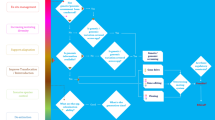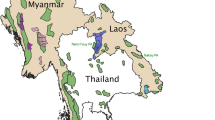Abstract
Seaweed farming has been the cause of introductions of non-indigenous seaweed species and genotypes throughout the world. In Zanzibar, Tanzania, foreign genotypes of Eucheuma denticulatum were introduced for farming purposes in 1989, and in recent years a spread of non-indigenous haplotypes has been reported. The current study aimed to investigate the presence and extent of introduced and native haplotypes of E. denticulatum as well as their relative frequencies, to obtain the severity of the spread of cultivated seaweed and the current state of the native populations. The results show that all investigated sites are dominated by the introduced South-east Asian haplotypes, even where seaweed farming has never occurred. As the frequencies of East African haplotypes are remarkably low, this shows a shift from native to introduced E. denticulatum. This shift may, at least in part, be caused by earlier overharvest of natural seaweed populations, and indicates a cryptic invasion of the introduced haplotypes at the potential cost of the recovery of the native haplotype populations.



Similar content being viewed by others

References
Able KW, Hagan SM (2000) Effects of common reed (Phragmites australis) invasion on marsh surface macrofauna: response of fishes and decapod crustaceans. Estuaries 23:633–646
Ask EI, Azanza RV (2002) Advances in cultivation technology of commercial eucheumatoid species: a review with suggestions for future research. Aquaculture 206:257–277
Ask EI, Batibasaga A, Zertuche-González JA, de San M (2003) Three decades of Kappaphycus alvarezii (Rhodophyta) introduction to non-endemic locations. Int Seaweed Symp 17:49–57
Barrios J, Bolaños J, López R (2007) Blanqueamiento de arrecifes coralinos por la invasion de Kappaphycus alvarezii (Rhodophyta) en Isla Cubagua, estado Nueva Esparta, Venezuela. Bol Inst Oceanogr Venezuela 46:147–152
Benoit LK, Askins RA (1999) Impact of the spread of Phragmites on the distribution of birds in Connecticut tidal marshes. Wetlands 19:194–208
Bergman KC, Svensson S, Öhman MC (2001) Influence of algal farming on fish assemblages. Mar Pollut Bull 42:1379–1389
Britton-Simmons KH (2004) Direct and indirect effects of the introduced alga Sargassum muticum on benthic, subtidal communities of Washington State, USA. Mar Ecol Prog Ser 277:61–78
Britton-Simmons KH (2006) Functional group diversity, resource preemption and the genesis of invasion resistance in a community of marine algae. Oikos 113:395–401
Bulboa CR, de Paula EJ (2005) Introduction of non-native species of Kappaphycus (Rhodophyta, Gigartinales) in subtropical waters: comparative analysis of growth rates of Kappaphycus alvarezii and Kappaphycus striatum in vitro and in the sea in south-eastern Brazil. Phycol Res 53:183–188
Chandrasekaran S, Nagendran NA, Pandiaraja D et al (2008) Bioinvasion of Kappaphycus alvarezii on corals in the Gulf of Mannar, India. Curr Sci 94:1167–1172
Conklin EJ, Smith JE (2005) Abundance and spread of the invasive red algae, Kappaphycus spp., in Kane’ohe Bay, Hawai’i and an experimental assessment of management options. Biol Invasions 7:1029–1039
Conklin KY, Kurihara A, Sherwood AR (2009) A molecular method for identification of the morphologically plastic invasive algal genera Eucheuma and Kappaphycus (Rhodophyta, Gigartinales) in Hawaii. J Appl Phycol 21:691–699
Didham RK, Tylianakis JM, Hutchison MA et al (2005) Are invasive species the drivers of ecological change? Trends Ecol Evol 20:470–474
Doty MS (1987) The production and use of Eucheuma. In: Doty M, Caddy J, Santelices B (eds) Case studies of seven commercial seaweed resources. FAO Fisher, Rome, pp 123–161
Doty MS (1988) Prodromus ad systematica Eucheumatoideorum: A tribe of commercial seaweeds related to Eucheuma (Solieriaceae, Gigartinales). In: Abbott IA (ed) Taxonomy of economic seaweeds: with reference to some Pacific and Caribbean species, vol II., California Sea GrantLa Jolla, CA, pp 157–207
Doty MS, Santos GA (1978) Carrageenans from tetrasporic and cystocarpic Eucheuma species. Aquat Bot 4:143–149
FAO (2010) The state of world fisheries and aquaculture 2010. Rome
FAO (2014) The state of world fisheries and aquaculture 2014. Rome
Ferrer E, Gómez Garreta A, Ribera MA (1997) Effect of Caulerpa taxifolia on the productivity of two Mediterranean macrophytes. Mar Ecol Prog Ser 149:279–287. doi:10.3354/meps149279
Glenn EP, Doty MS (1981) Photosynthesis and respiration of the tropical red seaweeds, Eucheuma striatum (tambalang and elkhorn varieties) and E. denticulatum. Aquat Bot 10:353–364
Halling C, Wikström SA, Lilliesköld-Sjöö G et al (2013) Introduction of Asian strains and low genetic variation in farmed seaweeds: indications for new management practices. J Appl Phycol 25:89–95
Hurtado AQ, Critchley AT, Trespoey A, Bleicher Lhonneur G (2006) Occurrence of Polysiphonia epiphytes in Kappaphycus farms at Calaguas Is., Camarines Norte Phillippines. J Appl Phycol 18:301–306
Hurtado AQ, Perpetuo Reis R, Loureiro RR, Critchley AT (2014) Kappaphycus (Rhodophyta) cultivation: problems and the impacts of Acadian Marine plant extract powder. In: Pereira L, Neto JM (eds) Marine Algae—Biodiversity, taxonomy environ assessment, biotechnology. CRC Press, USA, pp 251–299
Kamalakannan B, Jeevamani JJJ, Nagendran NA et al (2010) Turbinaria sp. as victims to Kappaphycus alvarezii in reefs of Gulf of Mannar, India. Coral Reefs 29:1077
Klein J, Verlaque M (2008) The Caulerpa racemosa invasion: a critical review. Mar Pollut Bull 56:205–225
Largo DB, Fukami K, Nishijima T (1995) Occasional pathogenic bacteria promoting ice-ice disease in the carrageenan-producing red algae Kappaphycus alvarezii and Eucheuma denticulatum (Solieriaceae, Gigartinales, Rhodophyta). J Appl Phycol 7:545–554
Levin PS, Coyer JA, Petrik R, Good TP (2002) Community-wide effects of nonindigenous species on temperate rocky reefs. Ecology 83:3182–3193
Lim PE, Tan J, Phang SM et al (2013) Genetic diversity of Kappaphycus Doty and Eucheuma J. Agardh (Solieriaceae, Rhodophyta) in Southeast Asia. J Appl Phycol 26:1253–1272
Lirasan T, Twide P (1993) Farming Eucheuma in Zanzibar, Tanzania. Hydrobiologia 260–261:353–355
MacDougall AS, Turkington R (2005) Are invasive species the drivers or passengers of change in degraded ecosystems? Ecology 86:42–55
Mairh OP, Zodape ST, Tewari A, Rajyaguru MR (1995) Culture of red alga Kappaphycus striatum (Schmitz) Doty on the Saurashtra region, west coast of India. Indian J Mar Sci 24:24–31
McClanahan TR (1988) Seasonality in East Africa’s coastal waters. Mar Ecol Prog Ser 44:191–199
Mollion J, Braud J-P (1993) A Eucheuma (Solieriaceae, Rhodophyta) cultivation test on the south-west coast of Madagascar. Hydrobiologia 260–261:373–378
Mshigeni KE (1973) Exploitation of seaweeds in Tanzania. Tanzan Notes Rec 72:19–36
Mshigeni KE (1979) The economic algal genus Eucheuma (Rhodophyta, Gigartinales): observations on the morphology and distribution ecology of Tanzanian species. Bot Mar 22:437–445
Mshigeni KE (1984) The red algal genus Eucheuma (Gigartinales, Solieriaceae) in East Africa: an underexploited resource. Hydrobiologia 116–117:347–350
Msuya FE (2011) Environmental changes and their impact on seaweed farming in Tanzania. World Aquac 42:34–37
Msuya FE, Salum D (2011) Effect of the presence of seagrass and nutrients on growth rates of farmed Kappaphycus alvarezii and Eucheuma denticulatum (Rhodophyta). West Indian Ocean J Mar Sci 10:129–135
Mtolera MSP, Collén J, Pedersén M, Semesi AK (1995) Destructive hydrogen peroxide production in Eucheuma denticulatum (Rhodophyta) during stress caused by elevated pH, high light intensities and competition with other species. Eur J Phycol 30:289–297
Muñoz J, Freile-Pelegrín Y, Robledo D (2004) Mariculture of Kappaphycus alvarezii (Rhodophyta, Solieriaceae) color strains in tropical waters of Yucatan, Mexico. Aquaculture 239:161–177
Parker HS (1974) The culture of the red algal genus Eucheuma in the Philippines. Aquaculture 3:425–439
Pettersson-Löfquist P (1995) The development of open-water algae farming in Zanzibar: reflections on the socioeconomic impact. Ambio 24:487–491
Piazzi L, Ceccherelli G, Cinelli F (2001) Threat to macroalgal diversity: effects of the introduced green alga Caulerpa racemosa in the Mediterranean. Mar Ecol Prog Ser 210:149–159
R Core Team (2014) R: A language and environment for statistical computing
Rodgers SK, Cox EF (1999) Rate of spread of introduced rhodophytes Kappaphycus alvarezii, Kappaphycus striatum, and Gracilaria salicornia and their current distributions in Kane’ohe Bay, O’ahu, Hawai’i. Pacific Sci 53:232–241
Saltonstall K (2003) Genetic variation among North American populations of Phragmites australis: implications for management. Estuaries 26:444–451
Tan J, Lim P-E, Phang S-M (2013) Phylogenetic relationship of Kappaphycus Doty and Eucheuma J. Agardh (Solieriaceae, Rhodophyta) in Malaysia. J Appl Phycol 25:13–29
Tisera WL, Naguit MRA (2009) Ice-ice disease occurrence in seaweed farms in Bais Bay, Negros Oriental and Zamboanga del Norte. Threshold 4:1–16
Vairappan CS, Chung CS, Hurtado AQ, et al (2008) Distribution and symptoms of epiphyte infection in major carrageenophyte-producing farms. J Appl Phycol 20:477–483
Valentine JP, Johnson CR (2003) Establishment of the introduced kelp Undaria pinnatifida in Tasmania depends on disturbance to native algal assemblages. J Exp Mar Bio Ecol 295:63–90
Wakibia JG, Bolton JJ, Keats DW, Raitt LM (2006) Factors influencing the growth rates of three commercial eucheumoids at coastal sites in Southern Kenya. J Appl Phycol 18:565–573
Wakibia JG, Ochiewo J, Bolton JJ (2011) Economic analysis of eucheumoid algae farming in Kenya. West Indian Ocean J Mar Sci 10:13–24
Willi Y, Van Buskirk J, Hoffmann AA (2006) Limits to the adaptive potential of small populations. Annu Rev Ecol Evol Syst 37:433–458
Williams SL, Smith JE (2007) A global review of the distribution, taxonomy, and impacts of introduced seaweeds. Annu Rev Ecol Evol Syst 38:327–359
Woo M, Smith C, Smith W (1999) Ecological interactions and impacts of invasive Kappaphycus striatum in Kane’ohe Bay, a tropical reef. In: Pederson J (ed) Marine bioinvasions. MIT sea grant college program, Cambridge, pp 186–192
Yarish C, Wamukoya G (1990) Seaweeds of potential economic importance in Kenya: field survey and future prospects. Hydrobiologia 204(205):339–346
Zemke-White WL, Smith JE (2006) Environmental impacts of seaweed farming in the tropics. In: Critchley AT, Ohno M, Largo D (eds) World Seaweed Resource., (CD-ROM series)ETI BioInformatics, University, Amsterdam, pp 1–42
Zuccarello GC, Lokhorst GM (2005) Molecular phylogeny of the genus Tribonema (Xanthophyceae) using rbcL gene sequence data: monophyly of morphologically simple algal species. Phycologia 44:384–392
Zuccarello GC, West JA, Kamiya M, King RJ (1999) A rapid method to score plastid haplotypes in red seaweeds and its use in determining parental inheritance of plastids in the red alga Bostrychia (Ceramiales). Hydrobiologia 401:207–214
Zuccarello GC, Critchley AT, Smith J et al (2006) Systematics and genetic variation in commercial shape Kappaphycus and Eucheuma (Solieriaceae, Rhodophyta). J Appl Phycol 18:643–651
Acknowledgments
We are indebted to Prof. Mats Grahn and Dr. Giuseppe Zuccarello for helping with the genetic analyses. The personnel at the Institute of Marine Sciences at Zanzibar are thanked for their help, especially Dr. Mtolera. Maria Eggertsen and Lisa Högström are thanked for their help during field work. The manuscript was improved by helpful comments from three anonymous reviewers. In situ research was conducted under permits issued by the Revolutionary Government of Zanzibar 20/10/2011 and 28/08/2012. The study was financed by Sida (SWE2010-052) and The Swedish Research Council (VR-348-2013-6146).
Author information
Authors and Affiliations
Corresponding author
Ethics declarations
Conflict of interest
The authors declare that they have no conflict of interest.
Additional information
Responsible Editor: T. Reusch.
Reviewed by undisclosed experts.
Rights and permissions
About this article
Cite this article
Tano, S.A., Halling, C., Lind, E. et al. Extensive spread of farmed seaweeds causes a shift from native to non-native haplotypes in natural seaweed beds. Mar Biol 162, 1983–1992 (2015). https://doi.org/10.1007/s00227-015-2724-7
Received:
Accepted:
Published:
Issue Date:
DOI: https://doi.org/10.1007/s00227-015-2724-7



